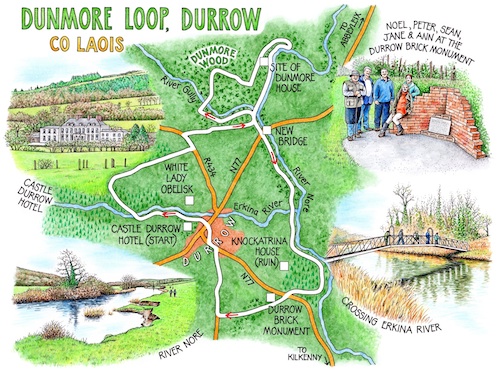On a cool, still morning, five of us set out from Durrow – local historians and ‘men of Durrow’ Sean Conroy and Noel Mooney, Sean’s sister Ann Lanigan (Co. Laois’s Rural Recreation Officer), Jane and myself – all ready to tackle the newly refurbished Dunmore Loop walk around Durrow’s green and pleasant countryside.

















Let’s face it – most self-respecting walkers would scarcely cast a glance in the direction of low-lying little Laois. But frankly, most self-respecting walkers need a bit of a slap, because in Durrow and its guardian rivers Nore, Gully and Erkina the walking world has got an unregarded treasure.
The grey stone 18th-century mansion of Castle Durrow Hotel looks down from its ridge across the Erkina towards the White Lady, a ghost-haunted obelisk on a green eminence. Down the lawns to join our rambling party came Peter Stokes, owner of the castle, a man happy to welcome one and all to enjoy his grounds and gardens, and keen to get his guests out walking Durrow’s river banks and woods. This need to share their good fortune in living in a beautiful spot seems endemic to Durrow folk, and a visiting walker can only rejoice at that.
We followed the Erkina River west through thick reedbeds and dense woodlands now being restored by Coillte to their natural status of wet carr woodlands where mosses thrive and fungi sprout. The old forests of Durrow, ‘plain of the oak’, were so dense in the 18th century that the outlaw captain Jeremiah Grant and his ruffian gang could hide out there in impunity (and his treasure is still buried in these woods, some say). But the early days of Independence saw mass felling of the local demesne woods, which are only now being properly cared for.
We crossed the Erkina by a footbridge and followed the path through woods of ash and silver birch. From the country lane beyond there was a magnificent view back over the fields to Castle Durrow on its ridge. ‘First time I saw it,’ said Peter, ‘the gates were chained shut, the avenue was completely overgrown and the house was rotten from top to bottom. I could stand in the basement and see the sky. Restoring it has been a nightmare and a dream come true, you know – more of the latter really…’
In among the slender beech trees of Dunmore Wood, knotty roots gripped the black earth. We met the River Nore and followed it to the tumble of mossy stones and barred cellar entrance of what was once Dunmore House. ‘I used to play in those cellars as a boy, when the old house was still standing as a ruin,’ mused Sean, staring down the hole in the ground. Dunmore was one of those country houses that suffered death by neglect, unroofed in the early 20th century to escape payment of rates, then left to rot until it could literally be knocked over with a bulldozer.
The Nore ran fast and slick under banks of crimson dogwood. The wooded path gave way to a lovely green stretch of open fields by the confluence of Nore and Erkina, overlooked by the eerie ruin of Knockatrina House, all empty gables and tall chimneys enclosed by a garden wall. A muddy stretch where dayglo orange fungi glowed among the leaf litter like fairies’ galoshes, and a pause by the monument to the long defunct Durrow Brick industry. Then we were easing downhill into Durrow, with the prospect of lunch at the castle to spur on weary feet.
WAY TO GO:
MAP: OS of Ireland 1:50,000 Discovery 60; downloadable map/instructions at www.discoverireland.ie/walking; mobile app downloadable at everytrail.com
GPS: satmap.com
TRAVEL: Bus Service 8 (Cork-Cashel-Dublin; buseireann.ie)
Road: M7, N77 to Durrow
WALK DIRECTIONS: Through Castle Durrow gates and up drive; in 100m, right past gate; follow ‘Dunmore Loop’, green arrows/GA. Path beside Erkina River; in 1km, right across footbridge (GA); on through woods to reach country road. Ahead to R434, left (GA) for 200m; right (GA) along L1652. In 300m demesne wall appears on left; in another 50m, left through wall (GA); on through Dunmore Wood. At forest road, left (GA); follow this for 4.5km (GAs) across River Gully, through Dunmore Wood and beside River Nore to New Bridge. Cross N77 here; on beside Nore. Below Knockatrina House ruin, bear right away from river; cross stile, left into woods (GA) to N77. Cross it; turn right for 150m to Durrow Brick monument. Left through barrier just beyond; right up forest track. Continue to road, right into Durrow; left at T-junction into village centre.
CONDITIONS: 15 km/9 miles (4 hours); easy; some muddy stretches in woodland.
DON’T MISS:
celandines and bluebells in the woods
eerie ruin of Knockatrina House, built for Robert Flower (1836-1919), heir of the Castle Durrow estates
REFRESHMENTS: Bob’s Bar, Durrow (087-616-5484 or 057-873-6630 for stout and chat; Castle Arms for soup and sandwiches); Castle Durrow Hotel tearoom open later this year.
BEST PICNIC SPOT: In meadows beside River Nore
ACCOMMODATION:
Castle Arms Hotel (057-873-6117; castlearmshotel.ie; 100 euros dble) and Ashbrook Arms Townhouse (057-874-0989; ashbrookarms.com; 100 euros dble) – two friendly family-run hotels in village centre.
Castle Durrow Hotel (057-873-6555; castledurrow.com; 210 euros dble dinner, B&B) – grand surroundings, warm atmosphere.
WALKING in IRELAND: Walking tour operators, local walks including Discover Ireland’s National Loop Walks, walking festivals throughout Ireland: www.discoverireland.ie/walking.
TOURIST OFFICE: Portlaoise (057-862-1178); laoistourism.ie
INFORMATION: Launch of Leafy Loop Walks, Durrow (March 18); Dawn Chorus in Dunmore Wood (5am, May 6); Laois Walks Festival (July 1-27) – contact Ann Lanigan (057-866-1900; annlanigan@laoispartnership.ie)